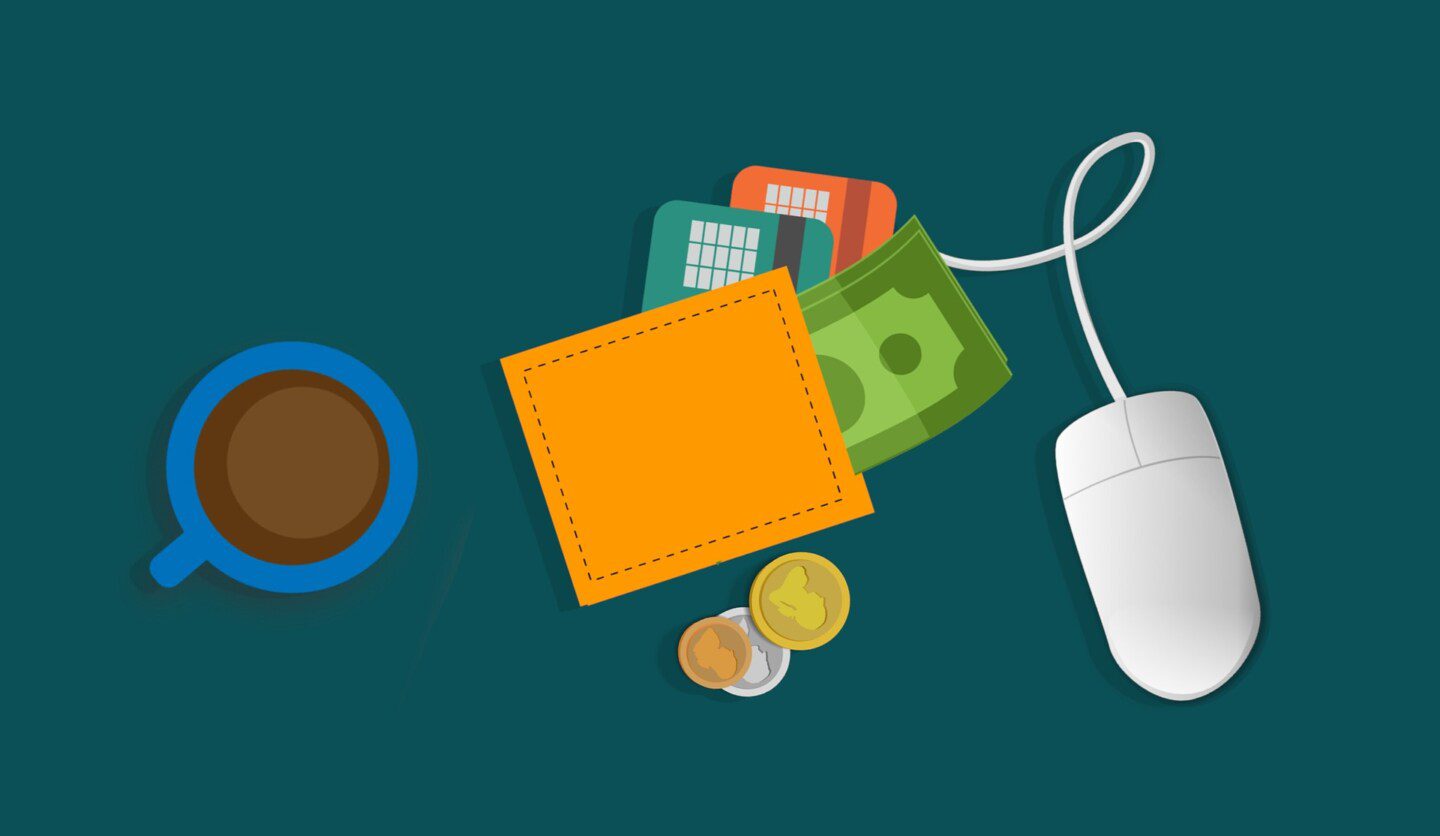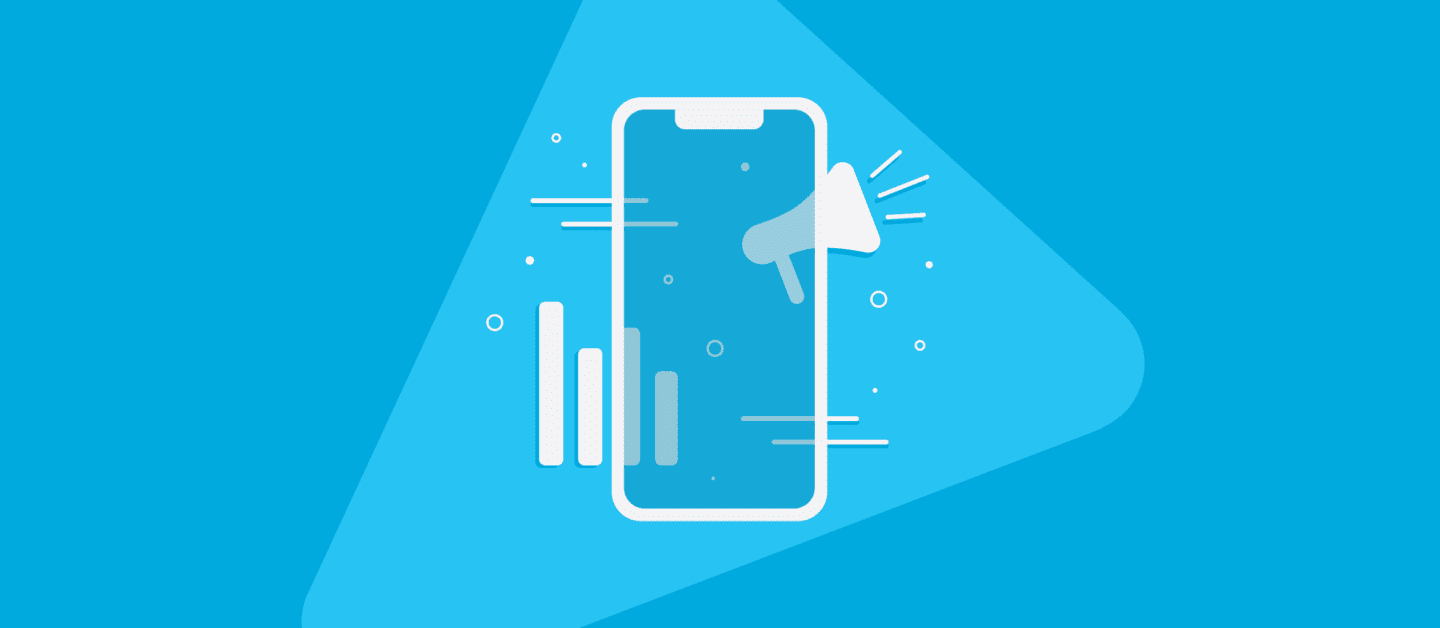We all feel a certain way about some brands and products. As the market became too saturated, the urge to classify and quantify those feelings emerged, as everybody wanted to excel in their respective business. It is hard to determine and measure customer loyalty, as everybody has different reasons and feelings behind being loyal to a brand. However, certain measuring formulas and strategies have been developed to quantify loyalty to a certain brand or program.
In this article, read about 10 metrics that measure customer loyalty, customer retention, customer satisfaction, and many more. Let’s dig deep into the numbers and psychology.
Net Promoter Score (NPS)
We’ve all been asked to fill out long boring surveys just as we wanted to step out of the retail store, right? Not many people are delighted when that happens. Net Promoter Score, also known as the NPS score, was developed in 2003 as a way to measure how well a business or an organization treats its clients or customers.
NPS score is a high-level KPI of the whole organization, not only its parts. It is a fast, simple, and inexpensive tool. A big number of responses makes it a representative and reliable way to measure the success of the whole organization, based on one simple question.

The responses can be divided into three categories:
- Promoters give scores of 9 or 10. They are the biggest fans, purchase regularly and recommend your business to everyone they know.
- Passives give scores of 7 and 8. They are mostly satisfied but lack the determination and enthusiasm to make a step forward and promote.
- Detractors give scores between 0 and 6. Their scale is the biggest which may seem unfair but the rules are the same for everyone. They tend to spread the negative word around based on their negative experience. It is important to find out why they are dissatisfied to improve what may not be working at the moment.
How to calculate an NPS score
To calculate your NPS score, subtract the percentage of your detractors from the percentage of your promoters. Passives are not included in the formula as they are mostly neutral.

Let’s give you a direct example. Assuming you collected 200 survey results and you have:
- Promoters: 90 (45%)
- Passives: 70 (35%)
- Detractors 40 (20%)
Applying the formula would result in an NPS score of 20. But, is that good or not? That depends. There is no clear indication of whether an NPS score is good or not. It can vary from -100 to 100. Anything above 0 means more people would recommend you than not.
Furthermore, you should calculate NPS scores over time and compare them with your older results. This will give you the best indication of in which direction your business is going. High NPS scores strongly correlate with repeat purchases, brand loyalty, and word-of-mouth.
Repeat Purchase Rate (RPR)
The repeat purchase rate is a simple yet effective metric that can provide powerful insight into customer loyalty. It represents the number of customers who return after the first purchase.
How to calculate the repurchase rate? It is quite simple. All you have to do is divide the number of returning customers by the number of one-time customers.
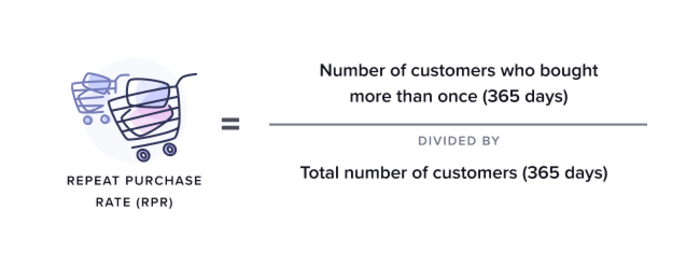
According to a study conducted by Adobe, 40% of revenue in the US comes from repeat purchasers who account for only 8% of all visitors. That is the power of returning customers and customer loyalty. For that reason, it is wise to research your loyal customers and see what they like and what interests them.
Knowing the repeat purchase rate will let you know how many customers might come back over time. One trick you can use to bait customers into coming back is to offer them a symbolic incentive such as a discount for the next purchase. That should be good enough of an incentive to come back and create a habit.
Customer Retention Rate (CRR)
Customer retention rate is one of the most important metrics for your business. It includes your ability to attract new customers, as well as keep the existing ones.
Why is customer retention so important? The research has shown that returning customers spend up to 67% more than new customers. Considering the high price of marketing campaigns, acquiring new customers is 6 to 7 times more expensive than retaining the current ones.
Several factors can influence the increase or drop in customer retention.
- Price: If your prices are too high and are not justified, you will lose your customers.
- Site performance: if your website is slow and it takes ages to load, that will turn off many people. Also, difficult navigation can cause a negative user experience.
- Delivery: Make sure that delivery doesn’t take too long, in contrast, that will demotivate people to continue ordering from you.
- Customer service: This can boost your retention rate or drop it massively. Have a professional and well-trained staff in that position.
- Loyalty programs: rewarding returning customers is a recipe for success. Once they see you appreciate their loyalty, they will come back more and more often.
CCR reflects the percentage of customers who remained loyal over a specific period. The average CCR usually falls below 20%.
How to calculate customer retention rate (CRR)
You need three data points to calculate the customer retention rate:
- the number of customers at the start of a period (CS)
- the number of customers at the end of a period (CE)
- the amount of customers acquired during that period (CA)
To calculate, subtract CA from CE, divide that number by CS, then multiply that figure by 100 to convert it into a percentage. Graphically, that would look like this:
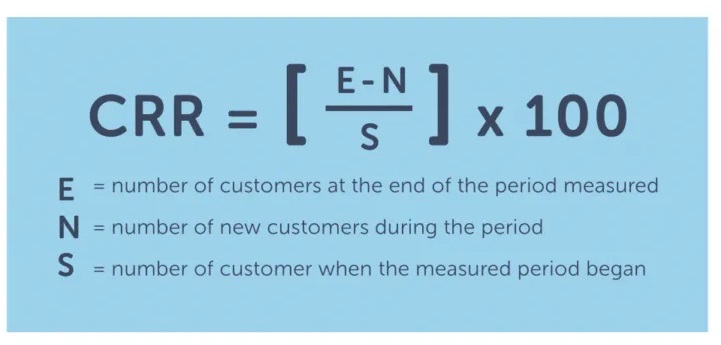
Customer Churn Rate (CCR)
Customer Churn Rate is the other side of the coin to say. If customer retention is customers who keep on returning, churn represents all those who came you’ve lost over a certain period.
You may also stumble upon the term attrition rate which is just another way to say customer churn rate. If the CCR is high, it indicates a large percentage of customers has been lost. Monitoring your churn rate helps uncover any trends that could impact your business and take effective measures to contain the churn from growing.
When calculating the churn is in question, the process is really simple. All you need to do is subtract your customer retention rate (CRR) from 100 and you will get the percentage of customer churn rate (CCR). For example, if your CRR is 22.5%, your CCR will be 77.5%, it’s that easy.
There is another way that is a bit longer, but you can also calculate the customer churn rate by dividing the number of customers you’ve lost by the total number of customers and multiplying that result by 100.
Try to understand where customers are falling off, why they have stopped making purchases, and how to improve your user experience to minimize churn.
Measure Loyalty Through Customer Satisfaction Score (CSS)
Customer satisfaction score (CSAT) differs from other loyalty metrics. It is easily determined and conducted through survey questions. An example of a question can be: How would you rate your overall satisfaction with our service? The rating scale is usually from 1-5, 1-7, or 1-10 points. The higher the number, the higher the customer satisfaction of course.

The customers get a CSAT questionnaire usually immediately after the purchase or after using some of the services. As the experience the customer had is still “fresh”, they will give more honest and more reliable feedback and score.
The CSAT score is calculated as a percentage of satisfied customers in the total number of respondents. If the score is 70% or higher, your customers are satisfied and you’re on the right track. One advantage of this metric is its simplicity and intuitiveness. The downside is that it is not very precise and detailed.
Moreover, if you want more detailed answers, you can ask a separate question for each segment of your business. You can test the satisfaction of the product quality, customer service experience, quality of delivery, price, etc.
Keep in mind that your actual score is a bit lower than what you see after calculating the results. People with negative experiences don’t want to always give feedback on the service.
Customer Acquisition Cost (CAC)
Customer Acquisition Cost is an objective measure of how much you spend to acquire a new customer. It can be calculated by adding up the amount you spend for your marketing activities (promotions, sales, advertising, campaigns) and dividing that number by the number of new customers you acquired during that time.
If costs are too high, maybe you should reconsider your marketing strategies and change your plans. Alongside customer lifetime value, CAC helps to determine the return on investment (ROI) in customer acquisition.
There are several tips to reduce CAC. Some of them include:
- Improving the website conversions: Have high-quality content that is optimized according to SEO principles and your conversion rate will increase.
- Implementing buyer personas that will resonate with your target audience and guide them through their shopping experience.
- Marketing automation is used to create personalized campaigns for both new and existing customers. You can recommend products, send them offers or answer their queries to keep them engaged with your brand.
- Invest in customer retention through loyalty programs
- Reduce churn by researching your customer satisfaction and experience
Customer Lifetime Value (CLV)
Customer lifetime value understands the total revenue attributed to a single customer, including future purchases. It might be one of the most important ways to measure customer loyalty for your business. The CLV helps you identify highly valuable customer segments but also shifts the focus on the relationship with a customer.
Knowing the CLV can help you accurately tweak business decisions about sales, marketing, product development, and customer support.
When customers are loyal, they spend more. If you run an eCommerce business, reconsider introducing a customer loyalty program for maximum customer retention. It will also boost your CLV over time.
Calculate CLV to measure customer loyalty
There are several ways in which you can determine CLV for your business. As the process can be time-consuming, many companies choose to use a predictive model, trying to estimate how a customer’s value will change over time.
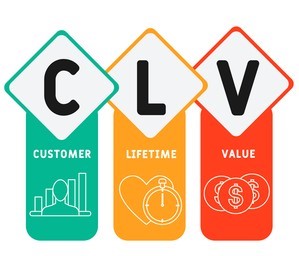
Bear with us now because the process is a bit long. We will break it down into segments and provide an example, which will hopefully, help you out understand CLV. You will need to know several other metrics beforehand.
- Average purchase value is the total revenue over a specified period divided by the number of purchases. For example, if the revenue for the past year equals $20,000 with 400 purchases, the average purchase value is $50.
- Average purchase frequency rate: divide the number of purchases (400) by the number of unique customers, say 180. The frequency rate would be 2.22.
- Customer value: multiply the frequency rate (2.22) by the average purchase value ($50). In this example, customer value equals $111.
- Average customer lifespan: the average amount of time between your customer’s first and last purchase measured in years. For this example, let’s say the customer’s lifespan is 5 years.
- Finally, multiply the average customer lifespan (5 years) by the customer value ($111). The total customer lifetime value would be $555. If your expenses to acquire and keep a customer are higher than that, you are losing money.
Measure Loyalty Through Customer Effort Scale (CES)
Customer Effort Score (CES) aims to determine the effort the customer needs to make to accomplish what they planned. You can say it is a combination of the Net Promoter Score (NPS) and Customer Satisfaction Score (CSAT).
In their book, The Effortless Experience, authors Matthew Dixon, Nick Toman, and Rick DeLisi argue that the best approach is to “make things easy”.
Their research found customer service interactions are nearly 4 times more likely to lead to disloyalty than loyalty. This is because so few interactions are genuinely low effort. They found that 96% of customers who invested high effort to resolve their issues are more disloyal, compared to just 9% of those in low-effort interactions.
Customers are not grading their satisfaction, but rather how easy their interaction with your business was. The prototypical question is: “Did the company make it easy for you to handle your issue?”
Respondents give scores from 1 to 7 where 1 stands for “strongly disagree” whereas 7 stands for “strongly agree”. To measure the score, count the average of all collected answers.
If the score is too low, it means that your customers are putting too much effort to get things done. Reducing customer effort makes life easier for customers and improves their impression of the brand and their overall customer experience.
Customer Loyalty Index (CLI)
The Customer Loyalty Index (CLI) is a standardized tool that is used to measure customer loyalty over time. CLI takes into consideration NPS, upselling, and repurchasing. It addresses these three questions:
- How likely are you to recommend us to your friends and family?
- Is it likely that you are going to buy from us again in the future?
- How likely are you to try our other products?
The CLI for a customer is the average score of their three responses. The values the customer can give to each question range from 1 to 6. Each number translates to a specific number of points as visible in the following photo.

It is wise to periodically measure customer loyalty through CLI but don’t overdo it. Your customers will not like being bothered every time they come to buy something.
CLI can predict future retention rates and help you build loyalty easier. Some customers might not be honest while answering so take these results with a grain of salt. That is always the case with customers’ estimations as many of them have a different understanding of the scale as well. What is average for one person can be way below average for another for example.
Loyalty Program Metrics
Customer loyalty stands for a customer’s devotion to a company and how strongly they feel about purchasing from the same company over and over again. It represents the positive impression of the consumer towards a particular product, brand, or service. Customer loyalty reflects in customer satisfaction, the perceived value of customer experience, customer engagement, and features of the product, such as price, quality, etc. That is why you need to pay attention to how you are creating your customer loyalty program.
It is common sense that a customer will gladly return to the place where they were rewarded with something extra. Loyalty programs are an effective way to attract and retain customers, but each loyalty program is as strong as the number of customers who use it. Otherwise, you lose the money. Here are some metrics that can give you an indication of whether your loyalty program is doing you more harm than good.
- The participation rate represents the number of customers enrolled in the customer loyalty program against the total number of customers.
- The redemption rate stands for the number of redeemed rewards divided by the total number of issued rewards.
- The active engagement rate includes only those who are actively participating in the loyalty program in comparison to all others.
The Takeaway
It is important to measure customer loyalty over time as it is one of the best indicators of your progress. We also suggest you embrace several metrics you read about as one might not be enough to fully explore and measure customer loyalty. Find what works best for you and your business. May the customers stay with you and keep on coming over and over again!


